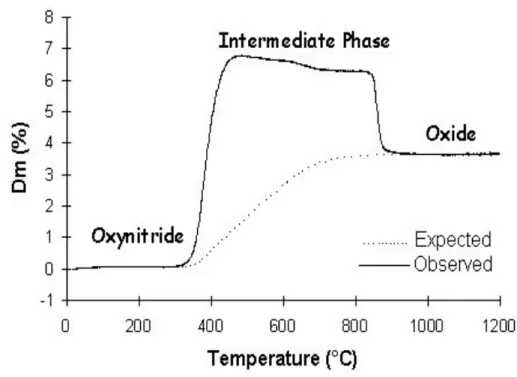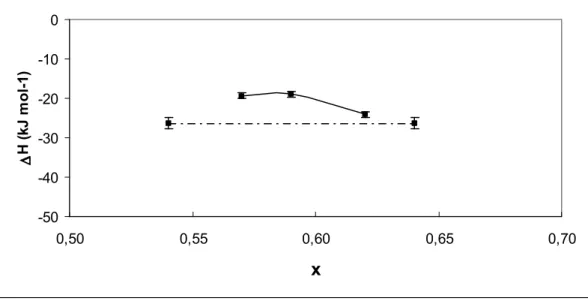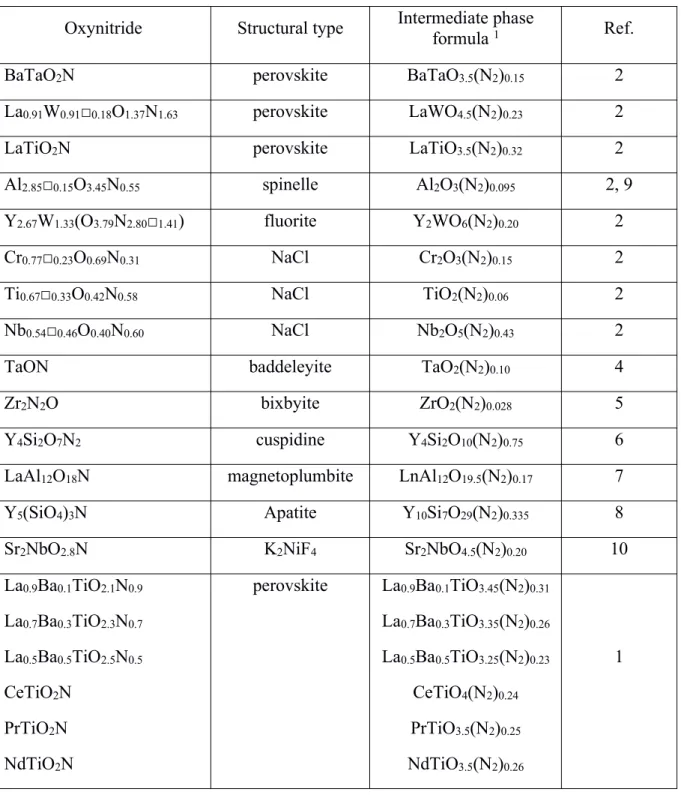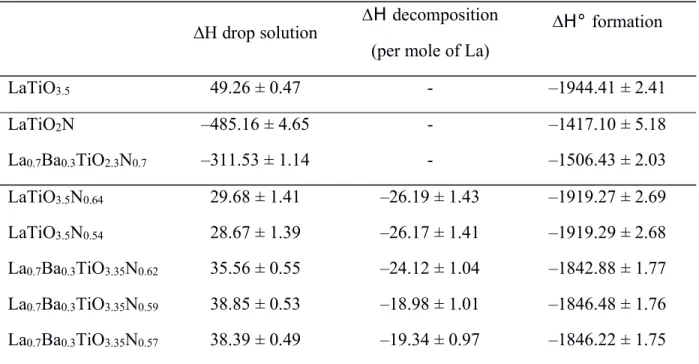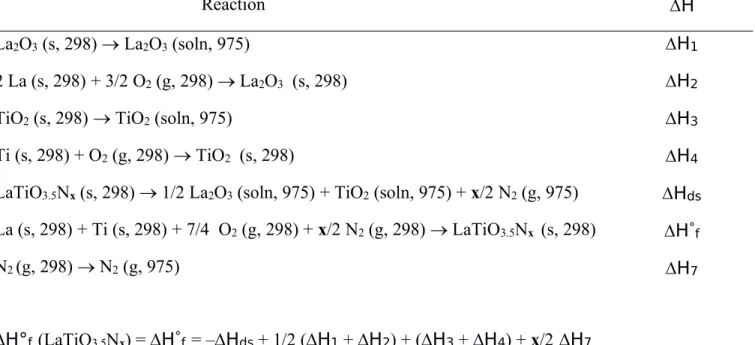HAL Id: hal-00773004
https://hal.archives-ouvertes.fr/hal-00773004
Submitted on 16 Feb 2016
HAL is a multi-disciplinary open access
archive for the deposit and dissemination of sci-entific research documents, whether they are pub-lished or not. The documents may come from teaching and research institutions in France or abroad, or from public or private research centers.
L’archive ouverte pluridisciplinaire HAL, est destinée au dépôt et à la diffusion de documents scientifiques de niveau recherche, publiés ou non, émanant des établissements d’enseignement et de recherche français ou étrangers, des laboratoires publics ou privés.
Thermochemistry of a New Class of Materials
Containing Dinitrogen Pairs in an Oxide Matrix
Franck Tessier, Laurent Le Gendre, François Cheviré, R. Marchand, A.
Navrotsky
To cite this version:
Franck Tessier, Laurent Le Gendre, François Cheviré, R. Marchand, A. Navrotsky. Thermochemistry of a New Class of Materials Containing Dinitrogen Pairs in an Oxide Matrix. Chemistry of Materials, American Chemical Society, 2005, 17 (13), pp.3570-3574. �10.1021/cm050402b�. �hal-00773004�
Thermochemistry of a new class of materials
containing dinitrogen pairs in an oxide matrix.
Franck Tessier, Laurent Le Gendre *, François Cheviré, Roger Marchand and Alexandra Navrotsky+
UMR CNRS 6512 "Verres et Céramiques", Institut de Chimie de Rennes, Université de Rennes 1, F-35042 Rennes cedex, France
* IUT de St-Brieuc, IETR, UMR CNRS 6164, Université de Rennes 1, F-22004 St-Brieuc,Cedex 01, France
+Thermochemistry Facility, University of California at Davis, Davis, California 95616-8779, USA
Correspondence should be addressed to Franck.Tessier@univ-rennes1.fr
ABSTRACT
A series of N2-containing perovskite phases was prepared in the La–(Ba)–Ti–O system in order to study
the dinitrogen retention phenomenon from a thermochemical viewpoint. High temperature oxide melt solution calorimetry was undertaken to determine the energetics of the corresponding starting oxynitrides, intermediate phases and oxides. Calorimetric results show that nitrogen is weakly bound within the oxide matrix and most of the enthalpy of oxidation of the intermediate phase is devoted to its structure change between the starting perovskite structure and the formation of a layered-perovskite La2Ti2O7oxide.
Introduction
Nitrides and oxynitrides represent a group of modern ceramic materials of increasing technological importance, with applications as hard materials, protective coatings, electronic and optical materials, refractories, and structural ceramics.
An important aspect of the use of nitride or oxynitride materials is their thermal oxidation behavior. Several investigations of nitride-type compounds have been made with the purpose of clarifying the oxidation mechanism during the transformation into oxide.1-3 When heated in an oxygen atmosphere, a
nitride or an oxynitride is systematically transformed at relatively high temperature into an oxide, or mixture of oxides, with nitrogen release as molecular dinitrogen. However, an intriguing family of oxynitrides shows a different behavior under similar conditions. As an example, different TGA profiles, under flowing oxygen, of the RTiO2N perovskite series with R = La, Ce, Pr, Nd are given in Figure 1.
An unexpected intermediate state, shown in Figure 2, appears between the starting oxynitride and final oxide, with an associated weight change surprisingly higher than that corresponding to the transformation into oxide. This behavior represents a dinitrogen retention phenomenon and the corresponding "intermediate phases" have been isolated and characterized as a new class of dinitrogen-containing inorganic compounds. This behavior has been frequently observed and many intermediate phases have been isolated and structurally characterized as indicated in Table 1.1-10 While a significant
number of organic dinitrogen-containing compounds, including conventional synthetic organometallic complexes,11 as well as biological substances,12 are known, the formation of such dinitrogen in
inorganic materials is extremely rare. Actually, M...NN or M...NN...M units have been only found in
the following cases: in pernitrides or diazenides as BaN2or SrN2,13,14prepared from the elements under
high N2 pressure, in products obtained by cocondensation of metallic atoms with N2 at low
temperature,15–28 in surface layers of titanium dioxide films during their bombardment by N2+ions,29as
molecular dinitrogen adsorbed on metallic or oxide substrates at low temperature,30–41 and in partially
oxidized (oxy)nitride materials, called “intermediate phases”, the subject of this paper.
that their general formula can be written Mn+O
n/2(N2)x. Such an intermediate phase composition implies
nitrogen atoms at a near zero oxidation state. By comparison to structures from organic chemistry, in particular of dinitrogen organometallic complexes, and also from XPS and Raman analysis,2,3 it has
been concluded that nitrogen is present as N–N pairs interacting with one or several cationic elements. The basic thermodynamic properties of (oxy)nitride compounds and the relations among energetics, structure and bonding are generally far less well known than for oxides. We have performed a calorimetric study to evaluate the energetics of the specific interaction between N2entities and the host
structure. Intermediate phases have been prepared starting from LaTiO2N and La0.7Ba0.3Ti(O,N)3
oxynitrides. High temperature oxidative drop solution calorimetry in a molten oxide solvent has been shown to be a general and convenient method to determine the heat of formation of nitrides and oxynitrides. Studies have already been successfully performed on the energetics of binary and ternary transition metal nitrides, Si3N4 and sialon systems, GaN and nitridophosphate PON and "LiNaPON"
glasses.42–46
Experimental Precursors
La2Ti2O7 precursor was prepared by molten salt synthesis.47 La2O3 and TiO2 were mixed in the
appropriate stoichiometric ratio, and a salt consisting of 50 mol.% NaCl / 50 mol.% KCl was then added, constituting 50 wt.% of the total reaction mixture. The corresponding mixture was heated at 1273 K for 15 h. The resulting product was washed using distilled water, then dried at 423 K, and clearly identified as La2Ti2O7(layered perovskite structure) by X–ray diffraction.
In the case of substituted oxynitrides La1–xBaxTi(O,N)3, the oxide precursor corresponds to a single
perovskite phase for x > 0.5, while a mixture La2–pBapTi2O7–p/2 + Ba1–qLaqTiO3+q/2 results for 0.1 < x <
0.5. The study was carried out with a precursor corresponding to x = 0.3.
Nitridation reactions were carried out in alumina boats placed inside an electric furnace through which ammonia gas flowed at 40–50 L h–1. The temperature was raised to the 1223–1273 K range with a
powders were allowed to cool to room temperature under a pure nitrogen atmosphere. Oxynitride perovskites LaTiO2N and La0.7Ba0.3TiO2.3N0.7were prepared and oxidized at 873 K to form intermediate
phases listed in Table 1.3
Characterizations X-ray diffraction.
XRD powder patterns were recorded using a Philips PW3710 diffractometer operating with CuK
radiation ( = 1.5418 Å). X’PERT softwares – Data Collector and Graphics and Identify – were used, respectively, for recording, analysis and phase matching of the patterns. The intermediate phase crystallizes, as previously observed,1–3 in the same structure type as its oxynitride precursor with a
diffraction profile typical of a poorly crystallized material.
Elemental analysis.
Nitrogen and oxygen contents were determined with a LECO TC–436 analyzer using the inert gas fusion method. Nitrogen was detected as N2 by thermal conductivity and oxygen as CO2 by infrared
detection. The apparatus was calibrated using N2and CO2gas (purity 99.95 %) as well as–TaN as a
nitrogen standard.48
Thermogravimetric analysis (TGA)
The oxidation behavior of the different oxynitride phases was investigated with a thermobalance Setaram TGDTA 92 in the 298–1673 K temperature range. The samples were tested in static air (P = 1 atm) with constant heating rates always lower than 1 K min–1. The phases present after oxidation were
identified by powder X-ray diffraction. Thermograms are similar to those previously obtained with other systems (Figures 1 and 2).1–10
X-ray photoelectron (XPS) and Raman spectroscopies.
XPS measurements were performed on a SSI model 206 spectrometer (Surface Science Instrument) equipped with a monochromatic Al K X–ray source (1486.6 eV). More experimental details are given
elsewhere.2,3,49XPS analysis show a single peak N1s close to 402 eV characteristic of N 2.
Room temperature Raman spectra were obtained with a Spectra Physics argon ion laser (Model 2000) excitation. The experimental setup was described earlier2 and Raman spectroscopy confirms the
previous XPS results: a single peak close to 2328 cm–1 reveals that the retained nitrogen exists as N 2
entities within a symmetric environment. The Raman peak position compares to that of 2330 cm-1in N2
gas, 1380 cm-1in SrN and 1307 cm-1in SrN
2((N2)2-pairs).50
Calorimetry
High temperature oxidative drop solution calorimetry into a 3Na2O–4MoO3 molten solvent was
performed in a Calvet type twin calorimeter described in detail by Navrotsky.51,52 The solvent was
prepared from Na2MoO4,2 H2O and MoO3, dehydrated and liquefied at 975 K, and quenched to room
temperature by pouring into a graphite dish. The melt does not quench to a glass, so the entire batch was ground to a powder to homogenize it before it was loaded into the calorimetric crucibles. Oxygen gas was used only for bubbling through the solvent (at ~5 cm3 min–1) to stir the melt and oxidize the
oxynitride sample once it reached the solvent. When a stable baseline signal was achieved, a sample pellet was dropped from room temperature into liquid 3Na2O–4MoO3at 975 K in the calorimeter. When
N3– is present, the calorimetry utilizes a redox reaction between MoO3 in the melt and N3–, which
supplies a rapid pathway for elimination of N3– as N2 gas. The reaction includes the oxidation and the
dissolution of the oxynitride, and represents the heat effect measured through oxidative drop solution calorimetry (ds). Further details of the experimental procedure are provided in previous papers.53–55
Drop solution calorimetry has been performed on oxynitride perovskites LaTiO2N and
La0.7Ba0.3TiO2.20N0.77, as well as on intermediate phases LaTiO3.5Nx (x = 0.54 and 0.64) and
La0.7Ba0.3TiO3.5Nx(x = 0.57, 0.59 and 0.62). Experimental enthalpies of drop solution are gathered in
Table 2. Resulting enthalpies of formation and oxidation have been determined from these data (Table 2 and 3) and appropriate thermodynamic cycles detailed in Tables 4 to 10. The enthalpy of formation of La2Ti2O7was determined from the cycle given in Table 6. The accuracy of the enthalpy of drop solution
of La2O3 (H1) was recently checked with a non hydrated sample and corrected to the value –225.10 ±
3.16 kJ mol–1.56 Using the experimental drop solution enthalpy value H5 = 98.52 ± 0.95 kJ mol–1
determined by Helean et al.,57 we establish the enthalpy of formation H°f (La
2Ti2O7) to –3890.92 ±
4.67 kJ mol–1and not –3855.5 ± 3.5 kJ mol–1as initially reported by these authors.
Heats of drop solution of nitrogen-containing intermediate phases are endothermic and within 20 kJ mol–1 of those of the nitrogen-free products. Thus, no major oxidation phenomenon, with associated
strong exothermic effect, is occuring. The enthalpies of formation of LaTiO3.5Nx phases are close to
each other and less exothermic than that of LaTiO3.5 oxide, as expected. The heat of drop solution of
intermediate phases does not depend much on nitrogen content, though there is not much variation in nitrogen content. The small difference in enthalpy suggests that nitrogen is weakly bound to the oxide network.
We have devised cycles (Tables 4 and 5) representing the oxidation of the intermediate phases as an approach to determine the energetic contribution of N2 pairs within the oxide matrix. The intermediate
phases La0.7Ba0.3TiO3.5Nx are not well cystallized but represent perovskite derived structures. They
decompose to crystalline BaTiO3 (perovskite) and La2Ti2O7 (layered perovskite). We suggest that the
observed enthalpy associated with release of N2gas contains two contributions, that from any oxidation
or bonding change of the dinitrogen and, that arising from the transformation of the LaTiO3.5 component
from the perovskite to the stable layered structure. However, only 0.7 mole of LaTiO3.5 is formed as
is necessary to divide the mixed system (La–-Ba–-Ti) by 0.7 to get the same number of moles of LaTiO3.5. Then, interestingly, we obtain a very similar heat effect to the pure La–Ti system. The
measured enthalpies of decomposition, between –19 and –26 kJ mol–1, are relatively constant,
suggesting that the phase transition dominates the energetics. Thus, most of the energetics is tied up with the structure change, from a perovskite to a layered-perovskite structure, and not with the N2
bonding. The release of nitrogen may have an effect on the 5–10 kJ mol–1level and the energetics of the
phase transition may release 20–25 kJ mol–1.
It is also possible to determine the energetics of formation of the oxynitride perovskite LaTiO2N from
the cycle in Table 7. Heat contents H975–H298 of N2 and O2 are respectively H7 = 20.65 and
H8 = 21.84 kJ mol–1 .58 From the enthalpy of drop solution Hds = –485.16 ± 4.65 kJ mol–1, we
calculate the enthalpy of formation H°f (LaTiO2N) = –1417.10 ± 5.18 kJ mol–1. A similar approach
allows us to determine the enthalpy of the barium-containing oxynitride perovskite La0.7Ba0.3TiO2.20N0.77.
From the thermochemical cycle given in Table 8 an enthalpy of formation H°f (La0.7Ba0.3TiO2.3N0.7)
= –1506.43 ± 2.03 kJ mol–1is obtained. Compared to the enthalpy of formation of LaTiO
2N, this value
is more exothermic. Barium has a stabilizing effect through the concept of the well known inductive effect in solid state chemistry,58 but the trend is not totally explained because nitrogen contents are
different and the differences in the standard enthalpies of BaO (–548.10 kJ mol–1) and La
2O3 (–1793.7
kJ mol–1) contribute as major factors.
Acknowledgment.
The authors are grateful for financial support from the France-Berkeley Fund and from the U.S. Department of Energy (grant DE–FG0397SF14749 ).
References
(1) Le Gendre, L.; Thesis n°1907, Université de Rennes, France, 1997.
(2) Le Gendre, L.; Marchand, R.; Laurent, Y. J. Eur. Ceram. Soc. 1997, 17, 1813.
(3) Le Gendre, L.; Marchand, R.; Piriou B. Eur. J. Solid State Inorg. Chem. 1997, 34, 973. (4) Ohran, E.; Tessier, F.; Marchand, R. Solid State Sci. 2002, 4, 1071.
(5) Clarke, S.J; Michie, C.W.; Rosseinsky, M.J. J. Solid State Chem. 1999, 146, 309.
(6) Van Krevel, J.W.H.; Hintzen, H. T.; Metselaar, R.; Le Gendre, L.; Marchand, R. Solid State Sci. 2001, 3, 49.
(7) Wang, X.H.; Lejus,A.-M.; Vivien, D. J. Am. Ceram. Soc. 1990, 73(3), 770. (8) Veyret, J.-B. ; Van de Voorde, M.; Billy, M. J. Am. Ceram. Soc. 1992, 75, 3289.
(9) Goursat, P.; Billy, M.; Goeuriot, P.; Labbe, J.C.; Villechenoux, J.M.; Roult, G.; Bardolle, J. Mat.
Chem. 1981, 6, 81.
(10) Tobias,G.; Oro-Sole, J.; Beltran-Porter, D.; Fuertes, A. Cryst. Eng. 2002, 5, 479. (11) Hidai, M.; Mizobe, Y. Chem. Rev. 1995, 95, 1115.
(12) Reis, V.M.; Baldani, J.I.; Divan Baldani, V.L.; Dobereiner, J. Crit. Rev. Plant. Sci. 2000, 19(3), 227.
(13) Auffermann, G.; Prots, Y.; Kniep, R. Angew. Chem. Int. Ed. 2001, 40(3), 547. Prots, Y.; Auffermann, G.; Tovar, M.; Kniep, R. Angew. Chem. Int. Ed. 2002, 41(13), 2288.
(14) Vajenine, G.V.; Auffermann, G.; Prots, Y.; Schnelle, W.; Kremer, R.K.; Simon, A.; Kniep, R.
Inorg. Chem. 2001, 40, 4866.
(15) Ozin, G.A.; Van der Voet, A. Can. J. Chem. 1973, 51, 3332.
(16) Burdett, J.K.; Turner, J.J. J. Chem. Soc., Chem. Commun. 1971, 16, 885. (17) Ozin, G.A.; Klotzbucher, W. J. Am. Chem. Soc. 1975, 97, 3965.
(18) Huber, E.; Kundig, E.P.; Moskovitz, M.; Ozin, G.A. J. Am. Chem. Soc. 1973, 95, 332. (19) Crichton, O.; Rest, A.J. J. Chem. Soc., Dalton Trans. 1977, 6, 536.
(20) De Vore, T.C. Inorg. Chem. 1976, 15, 1315.
(22) Busby, R.; Klotzbucher, W.; Ozin, G.A. Inorg. Chem. 1977, 16, 822.. (23) Green, D.W.; Hodges, R.V.; Gruen, D.M. Inorg. Chem. 1976, 15, 971.
(24) Burdett, J.K.; Graham, M.A.; Turner, J.J. J. Chem. Soc., Dalton Trans. 1972, 1620. (25) Rest, A.J. J. Organomet. Chem. 1972, C76, 40.
(26) Moskovits, M.; Ozin, G.A. J. Chem. Phys. 1973, 58, 1251.
(27) Andrews, L.; Citra, A.; Chertihin, G.V. ; Bare, W.D.; Neurock, M. J. Phys. Chem. A 1998, 102, 2561.
(28) Manceron, L.; Alikhani, M.E.; Joly, H.A. Chem. Phys. 1998, 228, 73.
(29) Wolff M., Schultze J.W., Strehblow H. H. Surf. And Interf. Analysis 1991, 17, 726. (30) Shinn, N.D.; Tsang, K.L. J. Vac. Sci. Technol. 1991, A9(3), 1558.
(31) Fuggle, J.C.; Menzel, D. Vakuum Technik 1977, 27(5), 130. (32) Johnson, D.W.; Roberts, M.W. Surf. Sci. 1979, 87, L255.
(33) Nilsson, A.; Tillborg, H.; Martensson, N. Phys. Rev. Lett. 1991, 67(8), 1015.
(34) Wakabayashi, F.; Kondo, J.; Wada, A.; Domen, K.; Hirose, C. J. Phys. Chem. 1993, 97, 10761. (35) Kameoka, S.; Kuroda, M.; Uetsuka, H.; Hito, S.; Kunimori,. K. J. Chem. Soc., Faraday Trans. 1996, 92(9), 1643.
(36) Atzei, D.; De Filipo, D.; Rossi, A. Spectrochim. Acta 1993, 49(A)-12, 1779. (37) Birchem, T.; Muhler, M. Surf. Sci. 1995, 334, L701.
(38) Wang, H.P; Yates Jr., J.T. J. Phys. Chem. 1984, 88, 852.
(39) Arumainayagam, C.R.; Tripa, C.E.; Xu, J.; Yates Jr., J.T. Surf. Sci. 1996, 360, 121.
(40) Vettraino, M.; Trudeau, M.; Lo, A. Y. H.; Schurko, R. W.; Antonelli, D. J. Am. Chem. Soc. 2002,
124(32), 9567.
(41) Recchia, S.; Dossi, C.; Psaro, R.; Fusi, A.; Ugo, R.; Moretti, G. J. Phys. Chem. B. 2002, 106(51), 13326.
(42) Navrotsky, A. J. Alloys Comp. 2001, 321, 300.
(43) Tessier, F.; Navrotsky, A.; Le Sauze, A.; Marchand, R. Chem. Mater. 2000, 12, 148.
(44) Tessier, F.; Navrotsky, A.; Niewa, R.; Leineweber, A.; Jacobs, H.; Kikkawa, S.; Takahashi, M.; Kanamaru, F.; DiSalvo, F.J. Solid State Sci. 2000, 2, 457.
(45) Ranade, M.R.; Tessier, F.; Navrotsky, A.; Leppert, V.J.; Risbud, S.H.; DiSalvo, F.J.; Balkas, C.M. J. Phys. Chem. B 2000, 104(17), 4060.
(46) Ranade, M.R.; Tessier, F.; Navrotsky, A.; Marchand, R. J. Mater. Res. 2001, 16(10), 2824. (47) Fuierer, P.A.; Newnham, R.E. J. Am. Ceram. Soc. 1991, 74, 2876.
(48) Dopita, M.; Wollein, B.; Rafaja, D.; Gruner, W.; Lengauer, W. Defect and Diffusion Forum, diffusion in materials DIMAT-2000 2001, 194-199, 1613.
(49) Wiame, H.; Centeno, M.-A.; Picard, S.; Bastians, P.; Grange, P. J. Eur. Ceram.Society 1998,
18(9), 1293.
(50) Auffermann, G.; Prots, Y.; Kniep, R.; Parker, S.F.; Bennington, S.M.; ChemPhysChem. 2002, 3, 815.
(51) Navrotsky, A. Phys. Chem. Miner. 1977, 2, 89. (52) Navrotsky, A. Phys. Chem. Miner. 1997, 24, 222.
(53) McHale, J.M.; Kowach, G.R.; Navrotsky, A.; DiSalvo, F.J. Chem. Eur. J. 1996, 2(12), 1514. (54) McHale, J.M.; Navrotsky, A.; Kowach, G.R.; Balbarin, V.E.; DiSalvo, F.J. Chem. Mater. 1997,
9, 1538.
(55) McHale, J.M.; Navrotsky, A.; DiSalvo, F.J. Chem. Mater. 1999, 11(4), 1148. (56) Cheng, J.; Navrotsky, A. J. Mater. Res. 2003, 18(10), 2501.
(57) Helean, K.B.; Ushakov, S.V.; Brown, C.E.; Navrotsky, A.; Liang, J.; Ewing, R.C.; Farmer, J.M.; Boatner, L.A. J. Solid State Chem. 2004, 177(6), 1858.
(58) Chase, M.W.; et al. JANAF Thermochemical Tables, 3rd ed.; Journal of Physical and Chemical
Reference Data; American Chemical Society: Washington, DC, (1985, Vol.14, Suppl. n°1).
(59) Robie, R.A.; Hemingway, B.S. Thermodynamic Properties of Minerals and related Substances
at 295.15K and 1 Bar (105Pa) Pressure and at Higher Temperatures (US Geological Survey Bulletin 2131, Washington DC, 1995).
(60) Ranade, M.R.; Navrotsky, A.; Zhang, H.Z.; Banfield, J.F.; Elder, S.H.; Zaban, A.; Borse, P.H.; Kulkarni, S.K.; Doran, G.S.; Whitfield, H.J. Proc. Nat. Acad. Sci. 2002, 99, suppl 2, 6476.
Figure 1. TGA under O2of RTiO2N phases (R = Ce, Pr, La and Nd) (1°C.min–1)
.
-50 -40 -30 -20 -10 0 0,50 0,55 0,60 0,65 0,70 x H ( kJ m o l-1)
Figure 3. Enthalpies of oxidation (per mole of lanthanum) versus nitrogen content within LaTiO3.5Nx
Table 1. Evidence of intermediate phases in several structure types
Oxynitride Structural type Intermediate phase
formula1 Ref.
BaTaO2N perovskite BaTaO3.5(N2)0.15 2
La0.91W0.91□0.18O1.37N1.63 perovskite LaWO4.5(N2)0.23 2
LaTiO2N perovskite LaTiO3.5(N2)0.32 2
Al2.85□0.15O3.45N0.55 spinelle Al2O3(N2)0.095 2, 9
Y2.67W1.33(O3.79N2.80□1.41) fluorite Y2WO6(N2)0.20 2
Cr0.77□0.23O0.69N0.31 NaCl Cr2O3(N2)0.15 2
Ti0.67□0.33O0.42N0.58 NaCl TiO2(N2)0.06 2
Nb0.54□0.46O0.40N0.60 NaCl Nb2O5(N2)0.43 2
TaON baddeleyite TaO2(N2)0.10 4
Zr2N2O bixbyite ZrO2(N2)0.028 5
Y4Si2O7N2 cuspidine Y4Si2O10(N2)0.75 6
LaAl12O18N magnetoplumbite LnAl12O19.5(N2)0.17 7
Y5(SiO4)3N Apatite Y10Si7O29(N2)0.335 8
Sr2NbO2.8N K2NiF4 Sr2NbO4.5(N2)0.20 10
La0.9Ba0.1TiO2.1N0.9 La0.7Ba0.3TiO2.3N0.7 La0.5Ba0.5TiO2.5N0.5 CeTiO2N PrTiO2N NdTiO2N perovskite La0.9Ba0.1TiO3.45(N2)0.31 La0.7Ba0.3TiO3.35(N2)0.26 La0.5Ba0.5TiO3.25(N2)0.23 CeTiO4(N2)0.24 PrTiO3.5(N2)0.25 NdTiO3.5(N2)0.26 1
Table 2. Enthalpies of drop solution, decomposition and formation from the elements at 298 K (kJ mol– 1) determined in this study.
drop solution H decomposition (per mole of La)
H° formation LaTiO3.5 49.26 ± 0.47 - –1944.41 ± 2.41 LaTiO2N –485.16 ± 4.65 - –1417.10 ± 5.18 La0.7Ba0.3TiO2.3N0.7 –311.53 ± 1.14 - –1506.43 ± 2.03 LaTiO3.5N0.64 29.68 ± 1.41 –26.19 ± 1.43 –1919.27 ± 2.69 LaTiO3.5N0.54 28.67 ± 1.39 –26.17 ± 1.41 –1919.29 ± 2.68 La0.7Ba0.3TiO3.35N0.62 35.56 ± 0.55 –24.12 ± 1.04 –1842.88 ± 1.77 La0.7Ba0.3TiO3.35N0.59 38.85 ± 0.53 –18.98 ± 1.01 –1846.48 ± 1.76 La0.7Ba0.3TiO3.35N0.57 38.39 ± 0.49 –19.34 ± 0.97 –1846.22 ± 1.75
uncertainty is two standard deviations of the mean.
Table 3. Data used in thermodynamic cycles to determine the enthalpy of formation from drop solution calorimetry. All values are in kJ mol–1.
drop solution H° formation Reference
La2O3 H1= –225.10 ± 3.16 H2 = –1793.7 ± 1.6 [59]
TiO2 H3= 57.95 ± 0.71 H4= –944.75 ± 1.26 [60]
La2Ti2O7 H5= 98.52 ± 0.95 H6= –3890.92 ± 4.67 this work
BaTiO3 H9= 38.53 ± 0.63 H10= –1659.797 [61]
Table 4. Thermochemical cycle for calculation of the enthalpy of decomposition of LaTiO3.5Nx
Reaction H
LaTiO3.5Nx(s, 298) LaTiO3.5(s, 298) + x/2 N2(g, 298)
LaTiO3.5Nx(s, 298) LaTiO3.5(soln, 975) + x/2 N2(g, 975)
LaTiO3.5 (s, 298) LaTiO3.5(soln, 975)
N2(g, 298) N2(g, 975) H = Hds – 1/2 H5 – x/2 H7 H Hds 1/2 H5 H7
Table 5. Thermochemical cycle for calculation of the enthalpy of decomposition of La0.7Ba0.3TiO3.35Nx.
Reaction H
La0.7Ba0.3TiO3.35Nx (s, 298) 0.7 LaTiO3.5 (s, 298) + 0.3 BaTiO3(s, 298) + x/2 N2
(g, 298)
La0.7Ba0.3TiO3.35Nx (s, 298) LaTiO3.5 (soln, 975) + 0.3 BaTiO3 (s, 975) + x/2 N2
(g, 975)
LaTiO3.5 (s, 298) LaTiO3.5(soln, 975)
BaTiO3(s, 298) BaTiO3(soln, 975)
N2(g, 298) N2(g, 975) H = Hds – 0.35 H5 – x/2 H7– 0.3 xH9 H Hds 1/2 H5 H9 H7
Table 6. Thermochemical cycle for calculation of the enthalpy of formation of La2Ti2O7.
Reaction H
La2O3(s, 298) La2O3(soln, 975)
2 La (s, 298) + 3/2 O2(g, 298) La2O3 (s, 298)
TiO2(s, 298) TiO2(soln, 975)
Ti (s, 298) + O2(g, 298) TiO2 (s, 298)
La2Ti2O7(s, 298) La2O3(soln, 975) + 2 TiO2(soln, 975)
2 La (s, 298) + 2 Ti (s, 298) + 7/2 O2(g, 298) La2Ti2O7(s, 298) H°f (La2Ti2O7) = H6= –H5+ H1 + H2 + 2(H3+ H4) H1 H2 H3 H4 H5 H6
Table 7. Thermochemical cycle for calculation of the enthalpy of formation of LaTiO2N.
Reaction H
La2O3(s, 298) La2O3(soln, 975)
2 La (s, 298) + 3/2 O2(g, 298) La2O3 (s, 298)
TiO2(s, 298) TiO2(soln, 975)
Ti (s, 298) + O2(g, 298) TiO2 (s, 298)
LaTiO2N (s, 298) + 3/4 O2(g, 975) 1/2 La2O3(soln, 975) + TiO2(soln, 975) + 1/2 N2(g,
975) La (s, 298) + Ti (s, 298) + O2(g, 298) + 1/2 N2(g, 298) LaTiO2N (s, 298) N2(g, 298) N2(g, 975) O2(g, 298) O2(g, 975) H°f (LaTiO2N) = H°f = –Hds + 1/2 (H1+ H2) +H3 + H4 + 1/2 H7– 3/4H8 H1 H2 H3 H4 Hds H°f H7 H8
Table 8. Thermochemical cycle for calculation of the enthalpy of formation of La0.7Ba0.3TiO2.3N0.7. Reaction H La2Ti2O7(s, 298) La2Ti2O7(soln, 975) 2 La (s, 298) + 2 Ti (s, 298) + 7/2 O2(g, 298) La2Ti2O7(s, 298) N2(g, 298) N2(g, 975) O2(g, 298) O2(g, 975)
BaTiO3(s, 298) BaTiO3(soln, 975)
Ba (s, 298) + Ti (s, 298) + 3/2 O2(g, 298) BaTiO3(s, 298) La0.7Ba0.3TiO2.3N0.7 (s, 298) + 0.525 O2 (g, 975) 0.35 La2Ti2O7 (soln, 975) + 0.3 BaTiO3(soln, 975) + 0.35 N2(g, 975) 0.7 La (s, 298) + 0.3 Ba (s, 298) + 1.15 O2 (g, 298) + 0.35 N2 (g, 298) La0.7Ba0.3TiO2.3N0.7 (s, 298) H°f (La0.7Ba0.3TiO2.3N0.7) =H°f = –Hds + 0.35 (H5 + H6) + 0.3 (H9+ H10) + 0.35H7 – 0.525H8 H5 H6 H7 H8 H9 H10 Hds H°f
Table 9. Thermochemical cycle for calculation of the enthalpy of formation of LaTiO3.5Nx
Reaction H
La2O3(s, 298) La2O3(soln, 975)
2 La (s, 298) + 3/2 O2(g, 298) La2O3 (s, 298)
TiO2(s, 298) TiO2(soln, 975)
Ti (s, 298) + O2(g, 298) TiO2 (s, 298)
LaTiO3.5Nx(s, 298) 1/2 La2O3(soln, 975) + TiO2(soln, 975) + x/2 N2(g, 975)
La (s, 298) + Ti (s, 298) + 7/4 O2(g, 298) + x/2 N2(g, 298) LaTiO3.5Nx (s, 298) N2(g, 298) N2(g, 975) H°f (LaTiO3.5Nx) = H°f= –Hds+ 1/2 (H1+ H2) + (H3+ H4) + x/2 H7 H1 H2 H3 H4 Hds H°f H7
Table 10. Thermochemical cycle for calculation of the enthalpy of formation of La0.7Ba0.3TiO3.35Nx. Reaction H La2Ti2O7(s, 298) La2Ti2O7(soln, 975) 2 La (s, 298) + 2 Ti (s, 298) + 7/2 O2(g, 298) La2Ti2O7(s, 298) N2(g, 298) N2(g, 975) O2(g, 298) O2(g, 975)
BaTiO3(s, 298) BaTiO3(soln, 975)
Ba (s, 298) + Ti (s, 298) + 3/2 O2(g, 298) BaTiO3(s, 298)
La0.7Ba0.3TiO3.35Nx(s, 298) 0.35 La2Ti2O7(soln, 975) + 0.3 BaTiO3(soln, 975) +
x/2 N2(g, 975) 0.7 La (s, 298) + 0.3 Ba (s, 298) + Ti (s, 298) + 1.675 O2(g, 298) + x/2 N2(g, 298) La0.7Ba0.3TiO3.35Nx(s, 298) H°f (La0.7Ba0.3TiO3.35Nx) = H°f = –Hds + 0.35 (H5 + H6) + 0.3 (H9 + H10) + x/2 H7 H5 H6 H7 H8 H9 H10 Hds H°f
